Review: DHD "Drone D1" Super Mini Quadcopter - even smaller than the Cheerson CX-10!
#1
Junior Member
Thread Starter
Join Date: Dec 2014
Posts: 26
Likes: 0
Received 0 Likes
on
0 Posts
Introduction:
Small, smaller, D1, seems to apply here. When I first saw this thing announced, it seemed like a gimmick, a "proof of concept" that something this small can fly, but probably just barely. It seems very similar to, or even identical to the Floureon FX-10 and Cheerson CX "Stars", though others reported big differences in flying performance. I was curious to see how it would fly, and gladly accepted when Banggood offered to send me a D1, which I agreed to under the sole condition that I would give an honest review of it.
http://www.banggood.com/D1-Drone-Min...-p-986728.html
Anyway, it is tiny, and probably the cutest looking quad you will see in a while, at least until someone releases something even smaller. To illustrate this, here is the D1 next to the well known Cheerson CX-10:
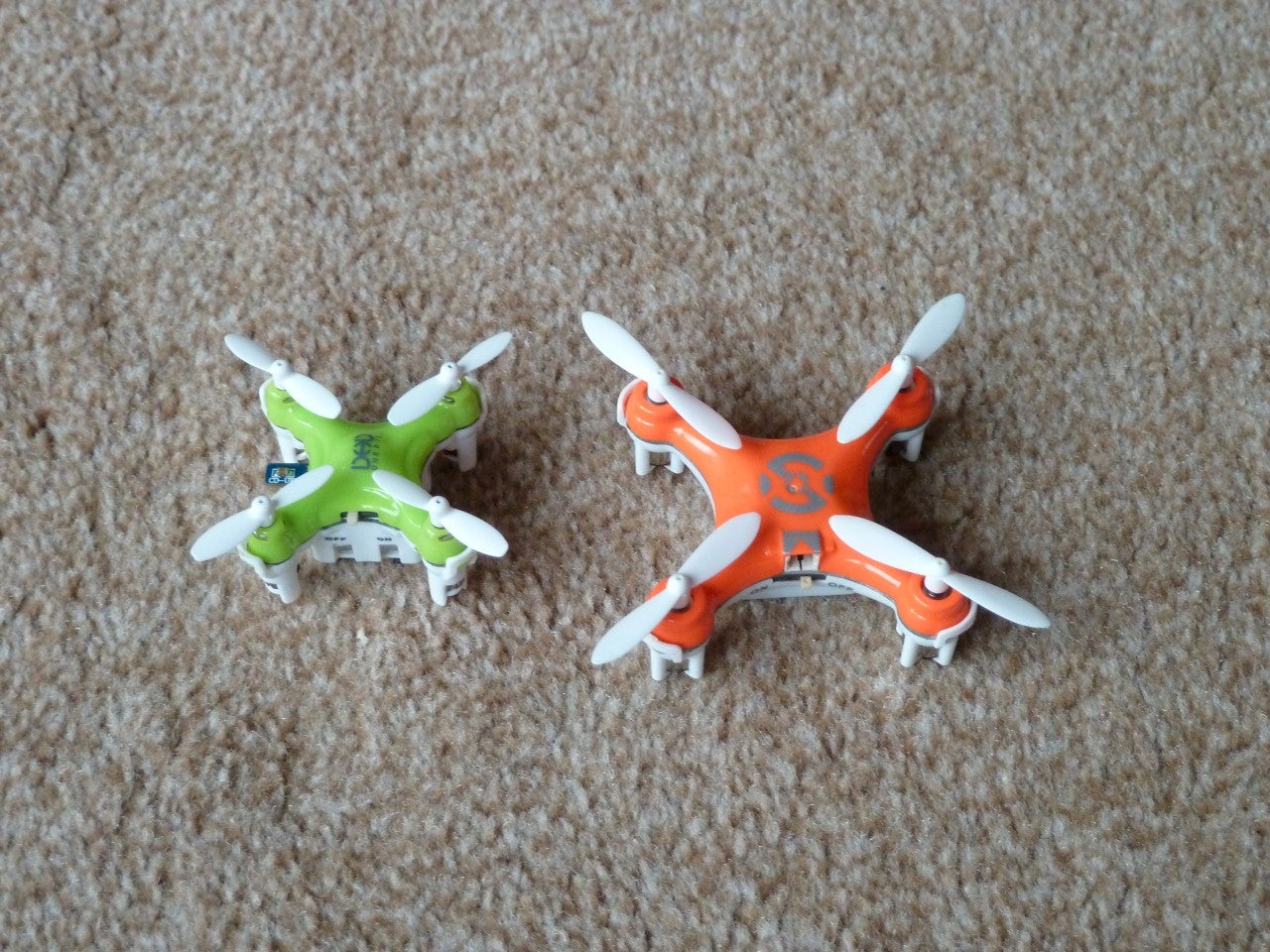
Now the CX-10 isn't exactly big, but it looks like a giant next to the D1. Let's have a little more look in detail...
First Impressions:
The quad is packed well, in a partially clear plastic box, that takes a little effort to open. The quad is very well protected, because it is held under a plastic cover, that is part of the TX itself. A neat feature, where the fragile blades are well protected, as you take the quad along with you.
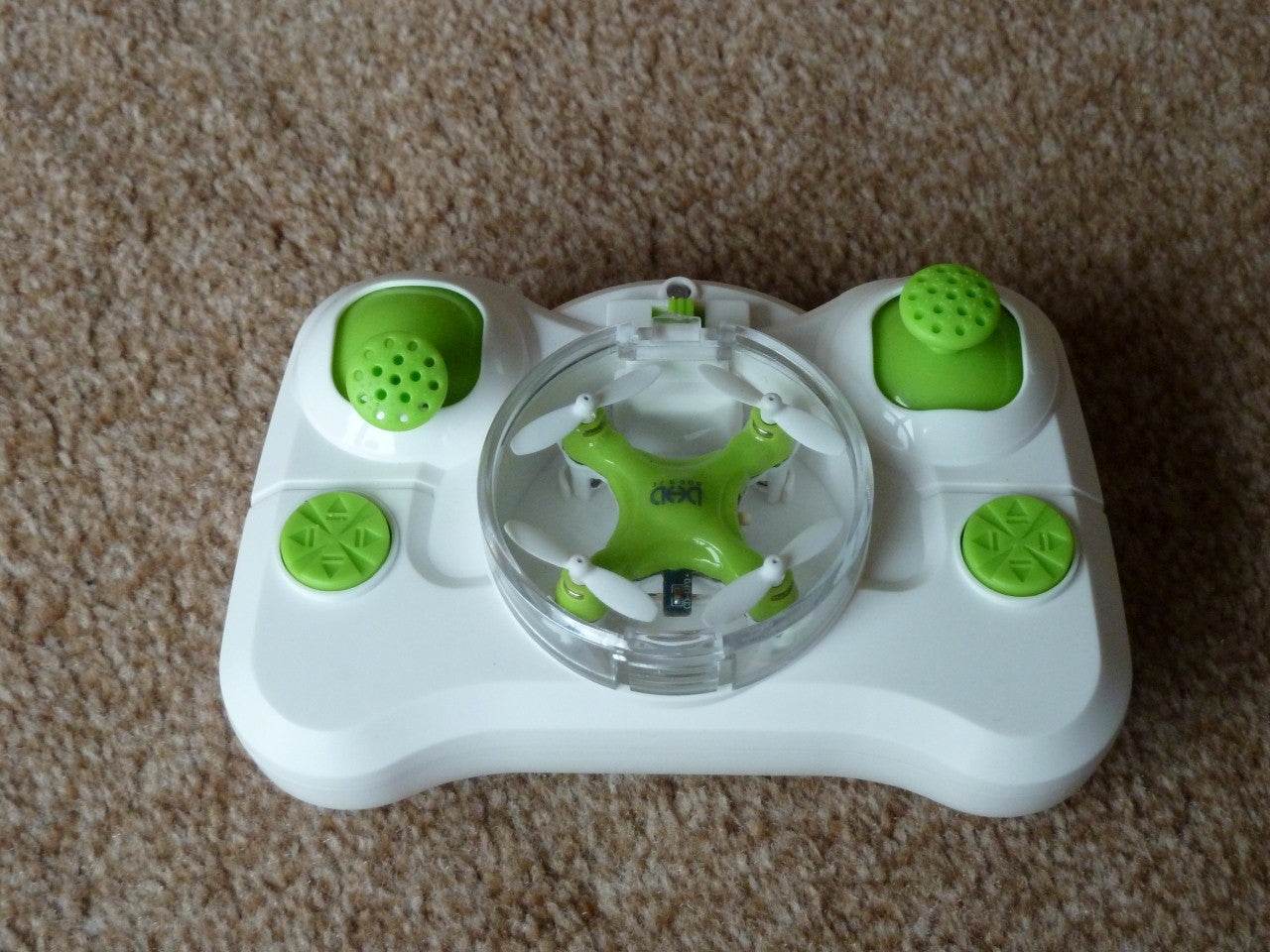
With the quad removed from it's "hangar bay" you can see four little C-shaped ridges, the hold the quad in place, so it can't slide side to side:
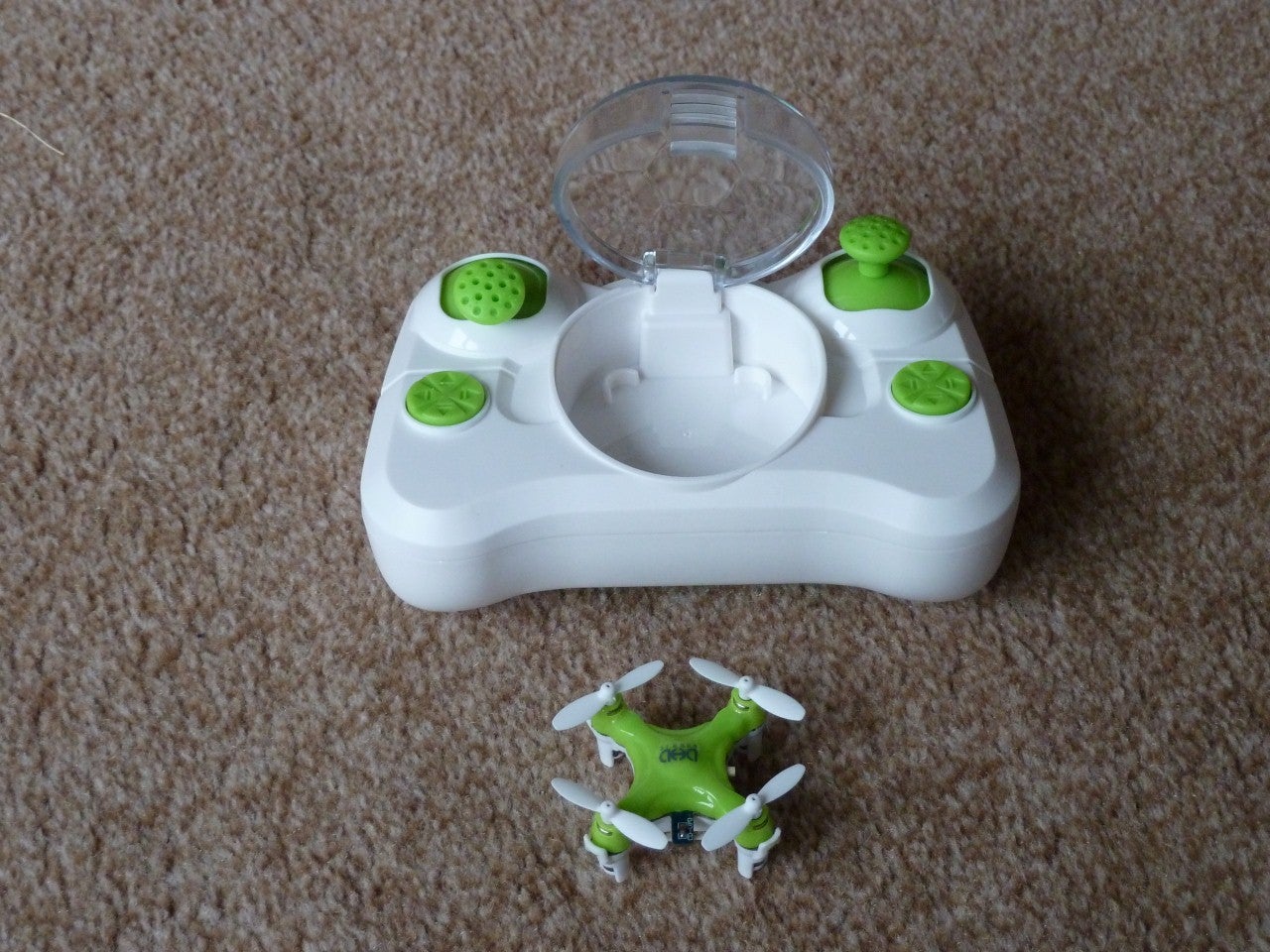
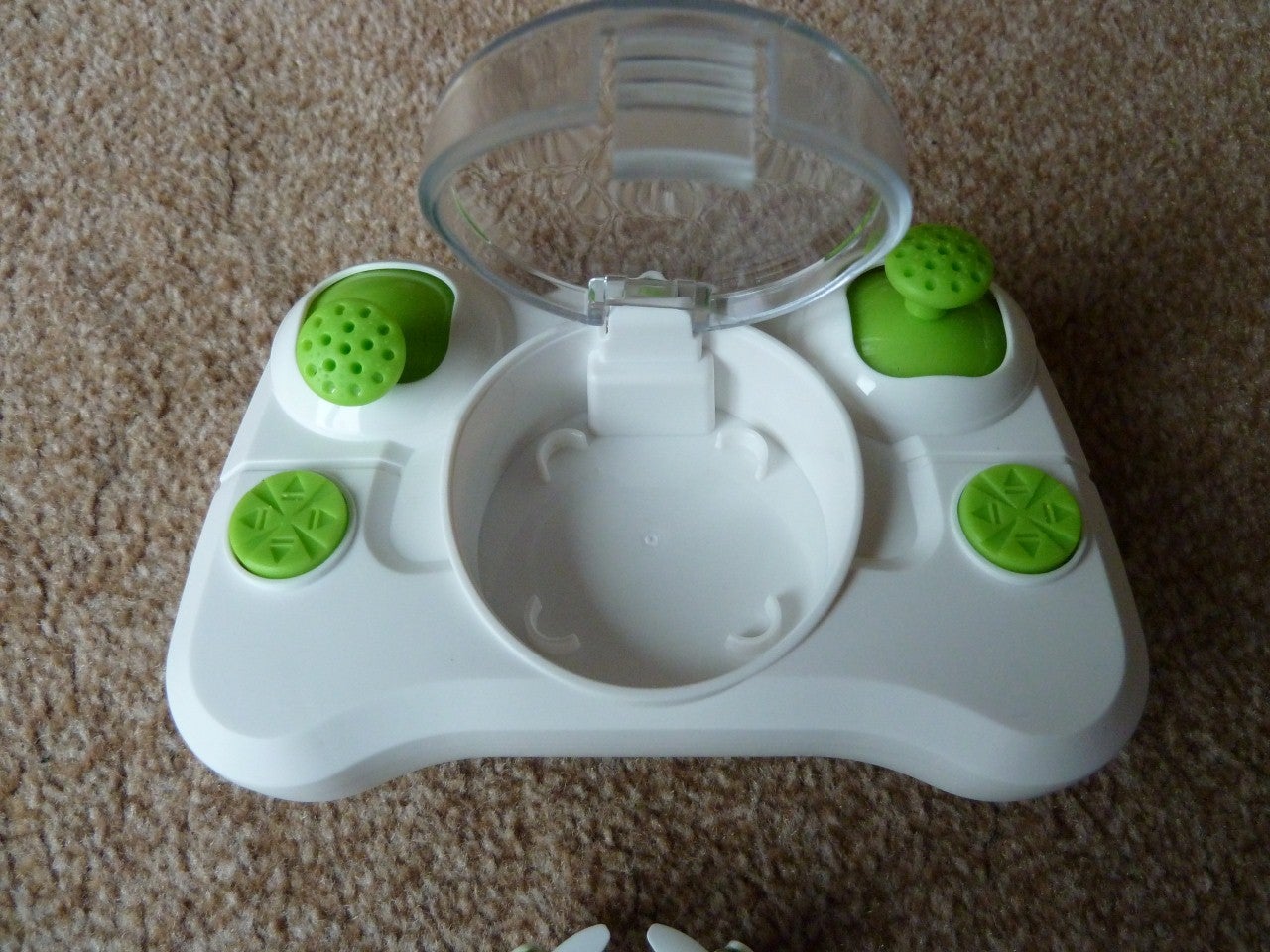
Inside the box are also a small plastic bag with USB charger and 4 spare blades (don't sneeze, or you will lose these... lol ) and a manual. The latter mentions the package should also contain a screwdriver, but I couldn't find any. Whether a packing error, or a fault of the manual, I don't know yet.
The quad has a very odd charge connector, consisting of a small protruding part of the PCB, with 2 metal strips. The charge connector of the USB charger slides over that, and thus contact with the battery is made.
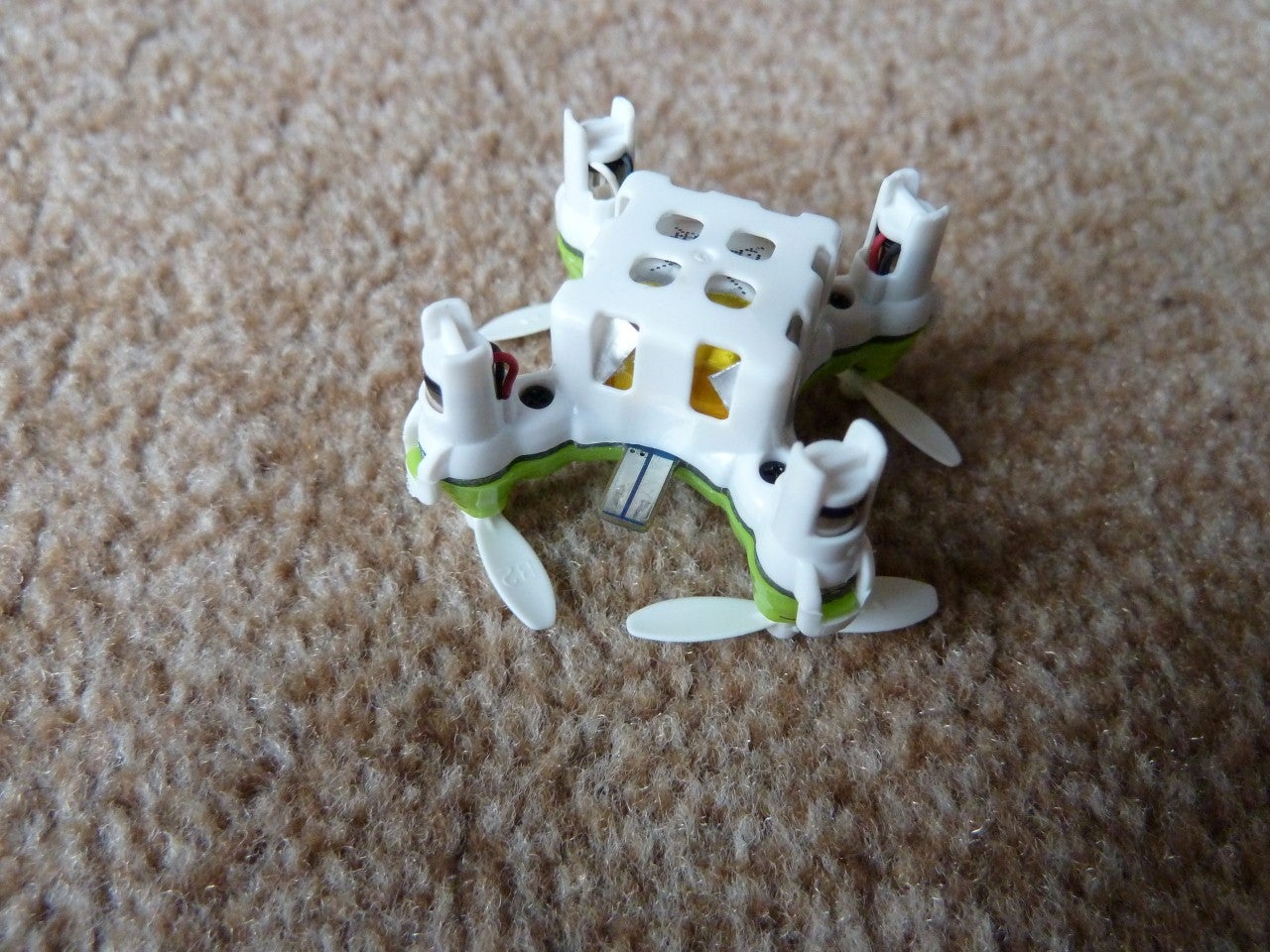
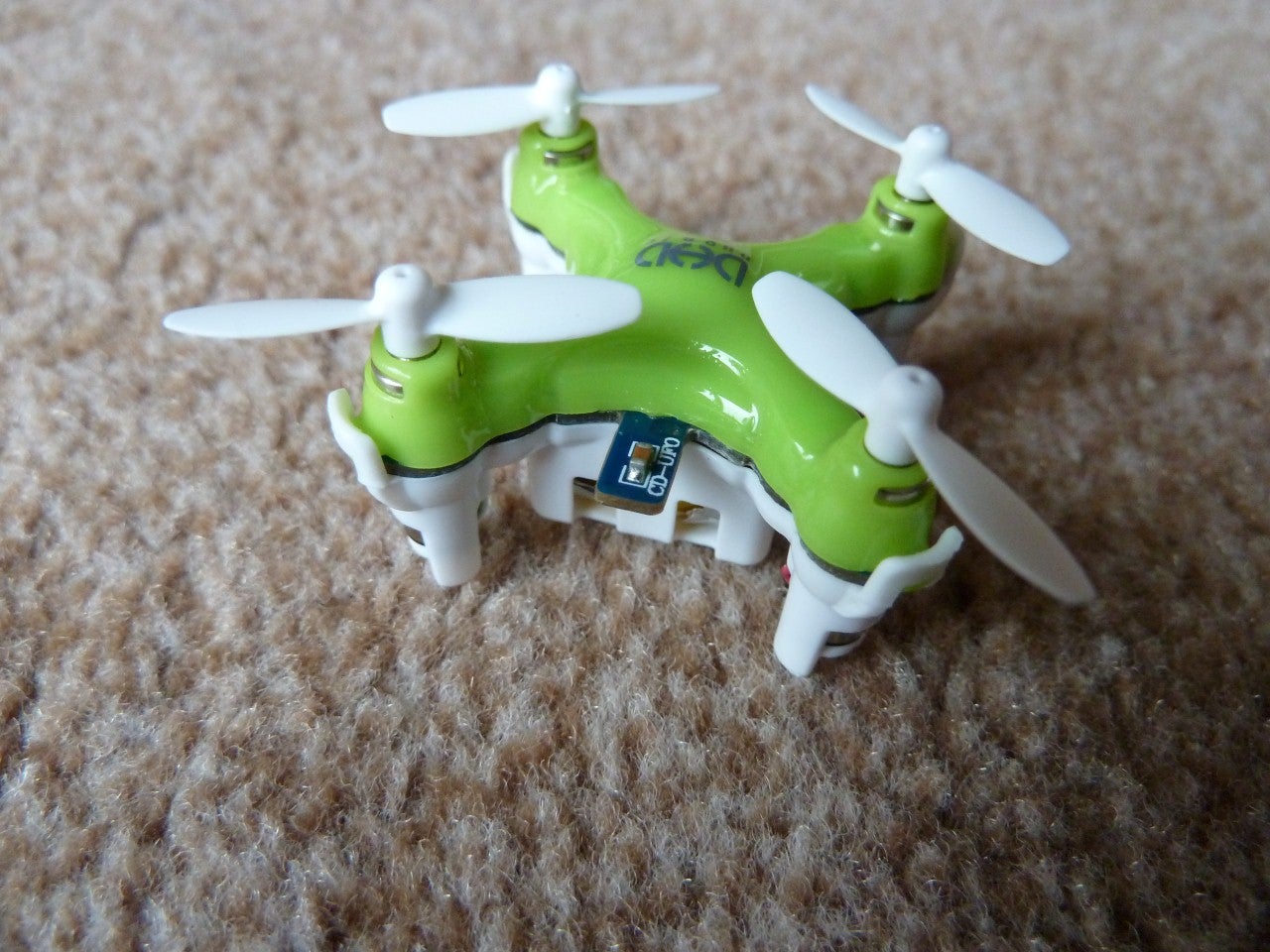
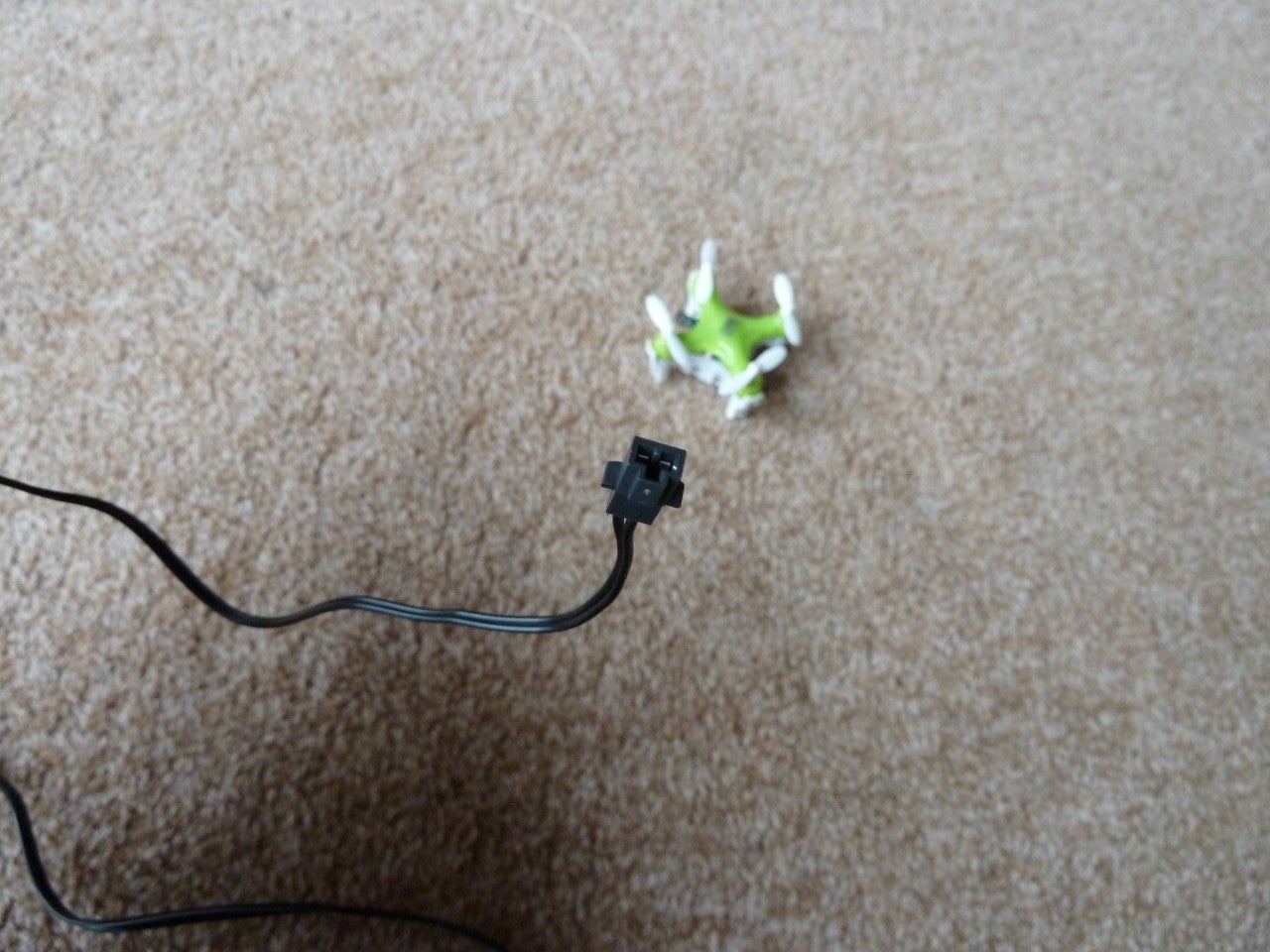
Charging takes around 20 to 25 minutes, which is fast, but the battery doesn't get very warm during charging. So it seems the charge rate is not set too high, and/or the lvc cuts off early, so the battery won't get drained very far. The exposed metal strips of the charge "connector" makes one wonder what will happen if grabbed with a wet finger, or something conductive touches the strips, creating a short. But there seems to be some built-in protection, because when checking with a volt-meter, there is only 0.8V present between both strips, which is much lower than battery voltage.
Because there is little room on the sides, the on/off switch is on another side than the charge "connector", which is on the rear. So if you put it down with the switch facing rearward, like you might be used to, from other nano quads, like the BayangToys X6, CX-10, or "LuLa" 8801, then to your surprise the D1 won't go forward if you press the elevator stick forward, but to the right instead.
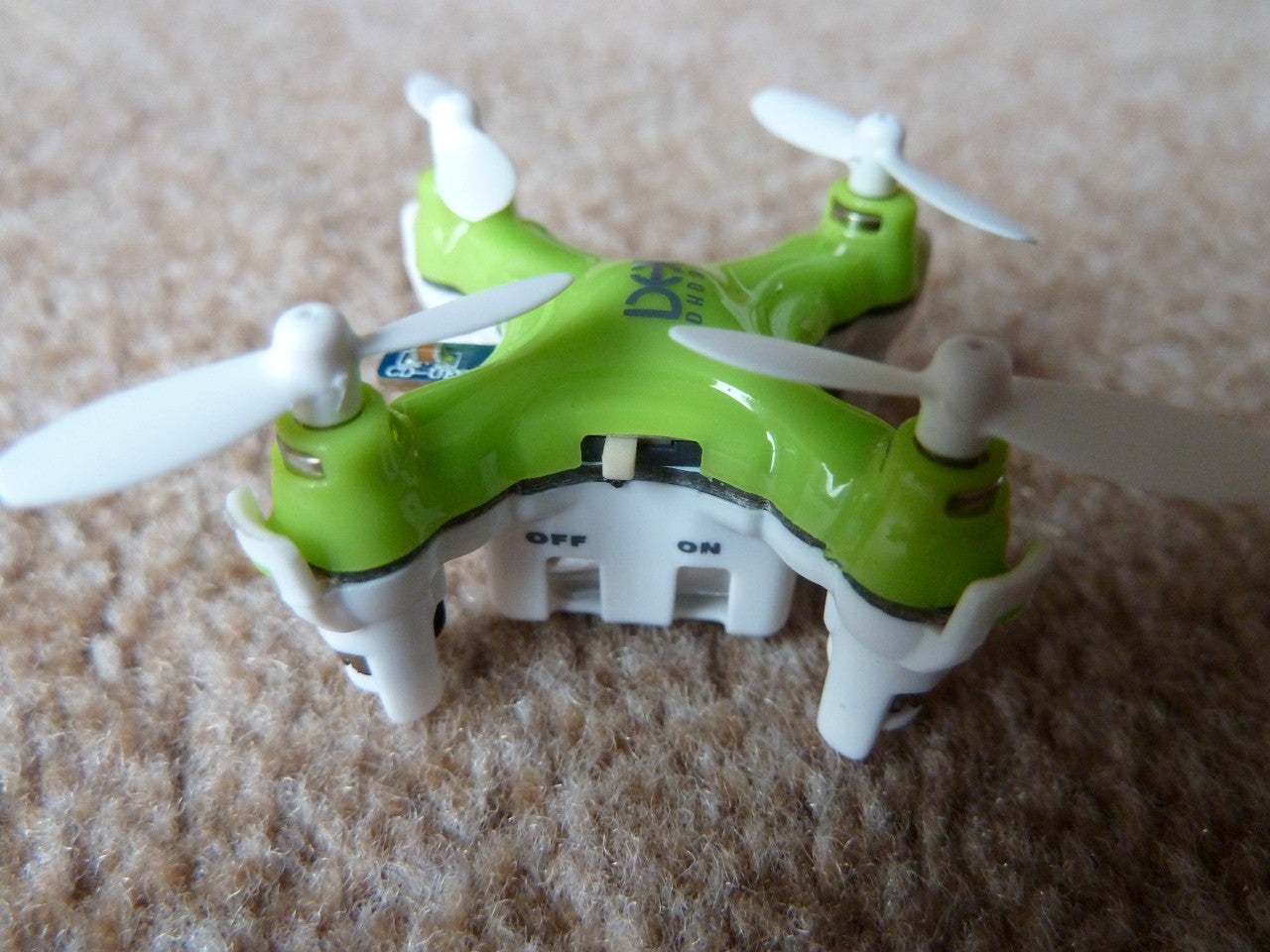
Battery on mine came charged, not really to my liking, I prefer to have it at storage level, but it did mean I could sneak in a quick flight right after unpacking it...
Flying Performance:
Well, pretty impressive. It hovered quite steady with zero trimming. Motors sounded pretty much synced too, and throttle response was good, but not overly nervous, which I would have expected from something this small. Like the CX10, it has 3 rates, activated by pressing down on the left stick. Sadly only the first 2 rates offer normal control, the 3rd rate is headless by default, and can't be changed to normal mode, AFAIK.
So I stuck to 2nd rate, and flew on that setting. Pitch angles are not very steep, but it does respond well, and yaw is good. It can make pretty tight turns, and overall control feel is much like a good CX10. Certainly not just a gimmick, it can really fly. The leds are also bright, as these should be, and not as dim as on some lately produced CX10, so flying in a dark environment, or keeping orientation with more light, should not be unneccesarily hard to do.
Flips are initiated by pressing the right stick down, and then pushing the right stick in the intending flipping direction. Flips are tight, I could pull off those when flying in the kitchen, with just 50 cm of clearence on either side of the quad.
Flight time is a little over 4 minutes, with some flips and doing circuits around the living room. Considering that the bigger cx10 barely gets 4 minutes, at least on the ones I have gotten lately, that is certainly acceptable. When the battery nears getting depleted, all 4 leds start to flash, so it is hard to miss lvc. In most cases there will be plenty of time left for a controlled landing.
Here's a short vid in less than ideal lighting conditions, trying to show it nimbly buzzing around, a flip (though it went out of picture frame, so I sharply reduced throttle hoping to keep it within view of the camera, hence the fast drop right after the flip) and at the end, LVC getting invoked:
http://vimeo.com/136650349
Btw, the transmitter can also bind to the Cheerson CX-10, at least the later versions, the first version uses a slightly different protocol, that isn't compatible with the current one. This is not only good news for CX-10 owners, as this transmitter is bigger and may be more comfortable to use, it also seems to imply that the Drone D1 can be flown with a "deviated" Devo transmitter!
Preliminary Verdict:
A nice (sub)nano size quadcopter, good control, bright leds that help with orientation, that is easy to take along with you.
Pro's:
- Flies way better than expected
- Good yaw rate
- Quad is well protected when placed in "storage container" on transmitter
- Adorable due to being so tiny
- Transmitter has a good size
- Decent flight time for it's size
- Flips well
- Bright leds
- Transmitter can be used to fly later versions of Cheerson CX-10
Cons:
- Only headless mode on highest rate setting, no normal mode on highest rates
- Built-in battery
- Uses a non-standard charge connector
Small, smaller, D1, seems to apply here. When I first saw this thing announced, it seemed like a gimmick, a "proof of concept" that something this small can fly, but probably just barely. It seems very similar to, or even identical to the Floureon FX-10 and Cheerson CX "Stars", though others reported big differences in flying performance. I was curious to see how it would fly, and gladly accepted when Banggood offered to send me a D1, which I agreed to under the sole condition that I would give an honest review of it.
http://www.banggood.com/D1-Drone-Min...-p-986728.html
Anyway, it is tiny, and probably the cutest looking quad you will see in a while, at least until someone releases something even smaller. To illustrate this, here is the D1 next to the well known Cheerson CX-10:

Now the CX-10 isn't exactly big, but it looks like a giant next to the D1. Let's have a little more look in detail...
First Impressions:
The quad is packed well, in a partially clear plastic box, that takes a little effort to open. The quad is very well protected, because it is held under a plastic cover, that is part of the TX itself. A neat feature, where the fragile blades are well protected, as you take the quad along with you.

With the quad removed from it's "hangar bay" you can see four little C-shaped ridges, the hold the quad in place, so it can't slide side to side:


Inside the box are also a small plastic bag with USB charger and 4 spare blades (don't sneeze, or you will lose these... lol ) and a manual. The latter mentions the package should also contain a screwdriver, but I couldn't find any. Whether a packing error, or a fault of the manual, I don't know yet.
The quad has a very odd charge connector, consisting of a small protruding part of the PCB, with 2 metal strips. The charge connector of the USB charger slides over that, and thus contact with the battery is made.



Charging takes around 20 to 25 minutes, which is fast, but the battery doesn't get very warm during charging. So it seems the charge rate is not set too high, and/or the lvc cuts off early, so the battery won't get drained very far. The exposed metal strips of the charge "connector" makes one wonder what will happen if grabbed with a wet finger, or something conductive touches the strips, creating a short. But there seems to be some built-in protection, because when checking with a volt-meter, there is only 0.8V present between both strips, which is much lower than battery voltage.
Because there is little room on the sides, the on/off switch is on another side than the charge "connector", which is on the rear. So if you put it down with the switch facing rearward, like you might be used to, from other nano quads, like the BayangToys X6, CX-10, or "LuLa" 8801, then to your surprise the D1 won't go forward if you press the elevator stick forward, but to the right instead.


Battery on mine came charged, not really to my liking, I prefer to have it at storage level, but it did mean I could sneak in a quick flight right after unpacking it...
Flying Performance:
Well, pretty impressive. It hovered quite steady with zero trimming. Motors sounded pretty much synced too, and throttle response was good, but not overly nervous, which I would have expected from something this small. Like the CX10, it has 3 rates, activated by pressing down on the left stick. Sadly only the first 2 rates offer normal control, the 3rd rate is headless by default, and can't be changed to normal mode, AFAIK.
So I stuck to 2nd rate, and flew on that setting. Pitch angles are not very steep, but it does respond well, and yaw is good. It can make pretty tight turns, and overall control feel is much like a good CX10. Certainly not just a gimmick, it can really fly. The leds are also bright, as these should be, and not as dim as on some lately produced CX10, so flying in a dark environment, or keeping orientation with more light, should not be unneccesarily hard to do.
Flips are initiated by pressing the right stick down, and then pushing the right stick in the intending flipping direction. Flips are tight, I could pull off those when flying in the kitchen, with just 50 cm of clearence on either side of the quad.
Flight time is a little over 4 minutes, with some flips and doing circuits around the living room. Considering that the bigger cx10 barely gets 4 minutes, at least on the ones I have gotten lately, that is certainly acceptable. When the battery nears getting depleted, all 4 leds start to flash, so it is hard to miss lvc. In most cases there will be plenty of time left for a controlled landing.
Here's a short vid in less than ideal lighting conditions, trying to show it nimbly buzzing around, a flip (though it went out of picture frame, so I sharply reduced throttle hoping to keep it within view of the camera, hence the fast drop right after the flip) and at the end, LVC getting invoked:
http://vimeo.com/136650349
Btw, the transmitter can also bind to the Cheerson CX-10, at least the later versions, the first version uses a slightly different protocol, that isn't compatible with the current one. This is not only good news for CX-10 owners, as this transmitter is bigger and may be more comfortable to use, it also seems to imply that the Drone D1 can be flown with a "deviated" Devo transmitter!
Preliminary Verdict:
A nice (sub)nano size quadcopter, good control, bright leds that help with orientation, that is easy to take along with you.
Pro's:
- Flies way better than expected
- Good yaw rate
- Quad is well protected when placed in "storage container" on transmitter
- Adorable due to being so tiny
- Transmitter has a good size
- Decent flight time for it's size
- Flips well
- Bright leds
- Transmitter can be used to fly later versions of Cheerson CX-10
Cons:
- Only headless mode on highest rate setting, no normal mode on highest rates
- Built-in battery
- Uses a non-standard charge connector





